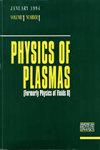双层条件下典型直流辉光放电等离子体中的电子俘获和脱俘
IF 2.2
3区 物理与天体物理
Q3 PHYSICS, FLUIDS & PLASMAS
引用次数: 0
摘要
观察到等离子体密度的下降与离子等离子体波的上升,证明了在直流辉光放电等离子体的双层条件下电子的脱离过程。本研究通过实验观察了当向浸没在等离子体中的平面探针施加高正向直流电压(Vp∼+100 V)时,电子和离子等离子体波之间的自激和相互作用。在较低的电压下(Vp∼+5 V),电子鞘在探针表面形成;然而,在施加足够高的电压时,等离子体无法提供足够数量的电子来屏蔽电子鞘,使其无法深入等离子体。因此,缺乏电子的鞘将等离子体电子吸引到探针上,从而激发等离子体波并形成双层。低能量流电子被困在双层势阱中。背景中子电离时,被捕获的电子被分离。这导致了离子波的激发和电子等离子体波的阻尼。对观测到的浮动电势波动的小波分析显示了电子和离子等离子体波之间的相互作用。电子的捕获会导致电子等离子体波的激发,而当电子密度整体下降时,电子的脱捕会导致离子等离子体波的激发。它为波浪相互作用的非线性效应、布涅曼不稳定性的发生以及双层条件下的流式不稳定性提供了新的见解。本文章由计算机程序翻译,如有差异,请以英文原文为准。
Trapping and detrapping of electrons in a typical DC glow discharge plasma under double layer condition
Observation of a dip in plasma density with the rise of ion plasma waves demonstrates the process of detrapping electrons under the double-layer conditions in a DC glow discharge plasma. This study presents an experimental observation of self-excitation and interplay between electron and ion plasma waves when a high positive DC voltage (Vp∼+100 V) is applied to a planar probe immersed in plasma. For lower voltages (Vp∼+5 V), the electron sheath forms on the surface of the probe; however, for sufficiently high applied voltage, plasma could not supply the sufficient number of electrons to shield it from penetrating deep into the plasma. Therefore, the electron-deficient sheath attracts plasma electrons toward the probe, resulting in the excitation of plasma waves and the formation of double layers. Low energy streaming electrons get trapped in the double layers potential step. On ionization of background neutrals, trapped electrons get detrapped. It results in the excitation of ion waves and damping of electron plasma waves. The wavelet analysis of the observed floating potential fluctuations exhibits the interplay between electron and ion plasma waves. The trapping of electrons causes the excitation of electron plasma waves, and detrapping results in the excitation of ion plasma waves as overall electron density dips. It provides new insight into the nonlinear effects of the wave–wave interaction, the onset of Buneman instability, and streaming instability under the double-layer condition.
求助全文
通过发布文献求助,成功后即可免费获取论文全文。
去求助
来源期刊

Physics of Plasmas
物理-物理:流体与等离子体
CiteScore
4.10
自引率
22.70%
发文量
653
审稿时长
2.5 months
期刊介绍:
Physics of Plasmas (PoP), published by AIP Publishing in cooperation with the APS Division of Plasma Physics, is committed to the publication of original research in all areas of experimental and theoretical plasma physics. PoP publishes comprehensive and in-depth review manuscripts covering important areas of study and Special Topics highlighting new and cutting-edge developments in plasma physics. Every year a special issue publishes the invited and review papers from the most recent meeting of the APS Division of Plasma Physics. PoP covers a broad range of important research in this dynamic field, including:
-Basic plasma phenomena, waves, instabilities
-Nonlinear phenomena, turbulence, transport
-Magnetically confined plasmas, heating, confinement
-Inertially confined plasmas, high-energy density plasma science, warm dense matter
-Ionospheric, solar-system, and astrophysical plasmas
-Lasers, particle beams, accelerators, radiation generation
-Radiation emission, absorption, and transport
-Low-temperature plasmas, plasma applications, plasma sources, sheaths
-Dusty plasmas
 求助内容:
求助内容: 应助结果提醒方式:
应助结果提醒方式:


